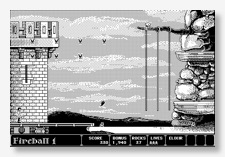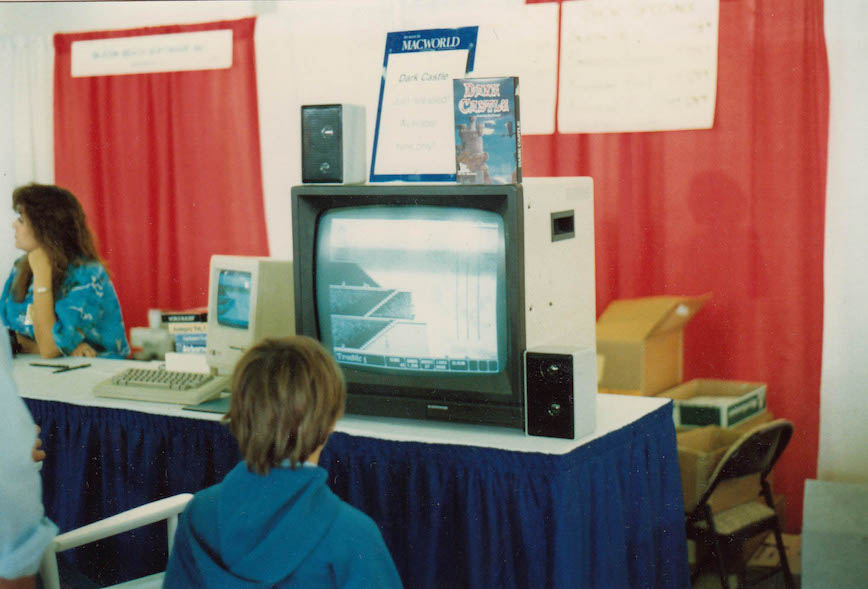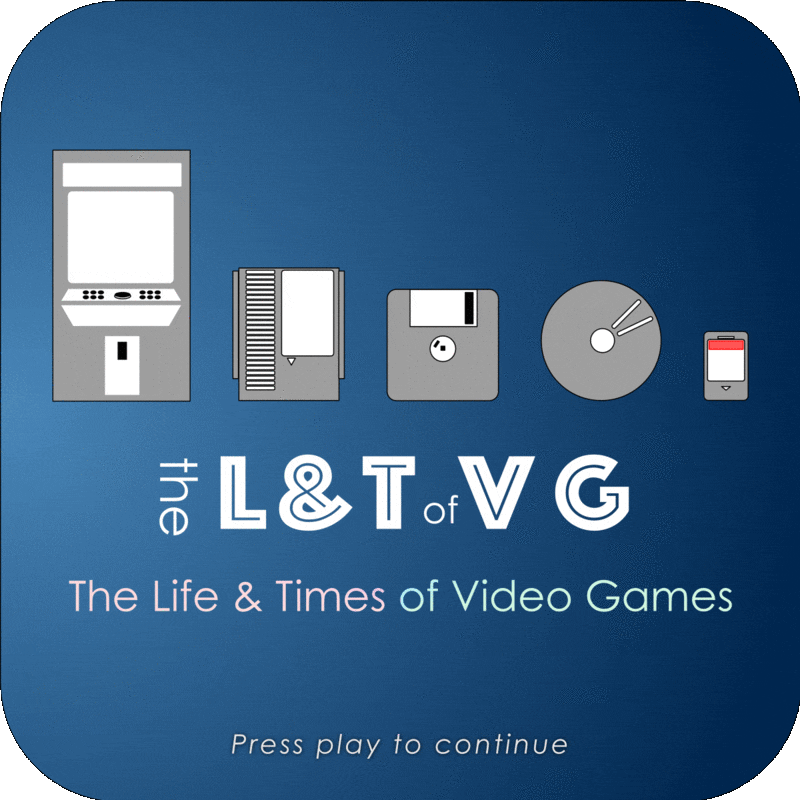20 - RealSound™ and Voice Characterisations
Become a Patron!

Features interviews with tech entrepreneur Charlie Jackson and former Adobe and Microsoft executive Eric Zocher, who together co-founded 1980s software company Silicon Beach Software — a pioneer in creative software tools and desktop publishing, as well as the publisher of several popular games (two of which we cover here: Airborne and the original Mac version of Dark Castle).
Adapted from a chapter on Silicon Beach Software in my book The Secret History of Mac Gaming.
- You can find more of Dick Noel's music via Discogs and the Internet Archive. And about his life in a brief obituary at The Hollywood Reporter.
Music and Sound Effects credits:
- A Dreamer's Holiday by Dick Noel with Ray Anthony and His Orchestra
- Explosion
- Crowd noise
- Continental Airlines ad from 1969
- Game audio clips taken from:
- Airborne (Mac, 1985)
- Dark Castle (Mac, 1986)
- The Three Stooges in Brides is Brides (arcade, 1984)
- Galaga (arcade, 1981)
- Donkey Kong (arcade, 1980)
- Ground Zero (Mac, 1984)
- Indiana Jones and the Fate of Atlantis (DOS, 1992)
- Dragon's Lair (arcade, 1983)
- PowerMonger (Amiga, 1990)
- Phrase Craze Plus (Mac, 1986)
- Spaceship Warlock (Mac, 1991)
- Spike (Vectrex, 1982)
- Sinistar (arcade, 1983)
- Shufflepuck Café (Mac, 1988)
- Elite (BBC Micro, 1984)
- Alley Cat (Atari 8-bit, 1983)
- Choplifter (Apple II, 1982)
- Ant Attack (ZX Spectrum, 1983)
- King's Quest (PCjr, 1984)
- The Black Cauldron (DOS, 1986)
- Manic Miner (ZX Spectrum, 1983)
- The Manhole (Mac, 1988)
- At the Carnival (Mac, 1989)
- Air Ace 2 (Amiga, 1989)
- Uncharted 2 (PS3, 2009)
- Mercenaries 2 (PS3/Xbox 360, 2008)
- Everything else is my own work
I've also just added a third way that you can donate to the show — a premium, ad-free feed on Breaker, where you'll get all the bonus audio that goes to Patreon (but none of the non-audio Patreon perks) for a monthly subscription of US$2.99. Head to https://www.breaker.audio/the-life-and-times-of-video-games-premium for more info.
(Partial) Transcript
[Play audio from Dark Castle 1 and Airborne]
These are, in a sense, the sounds of a revolution in videogame history, the sounds of a change so profound that it opened the door to entirely new genres. They're digitised audio samples, a recorded analogue waveform converted into a digital signal — and then back into analogue audio through your headphones, in this case, via a couple of Macintosh games from 1985 and 86.
We take this capability for granted nowadays, as we use our voice calling apps and record videos with our smartphones. And as we consume our digitally-recorded entertainment and news media. It's how you're hearing this podcast, too — I spoke into a microphone, which translated my voice into some binary data that computers can understand, and an audio chip built into your computer or phone or whatever device you're listening with translates the edited version back into a sound that you can understand.
But you only have to roll back the clock 35 years to get to a time when this sort of technology was beyond the reach of the masses — when digital audio was something only used by specialist researchers and archivists and cutting-edge or experimental sound engineers. And when the thought of using it on an off-the-shelf personal computer was almost unheard of.
But then the Apple Macintosh came out in January 1984. And Apple's so-called "computer for the rest of us" had a secret capability that would unlock this door to digital audio for the masses.
Eric Zocher: There were two ways you could play sounds on the early Macintosh.
This is Eric Zocher, who in 1984 was a computer science student at the University of California, San Diego, and a programmer on a small commercial game project called Airborne.
One was a sound driver they had written at Apple that was a four-voice synthesiser that would play square waves or just really simple waveforms. It could make beeps and little tones like people were familiar with in microcomputers at the time. So I started looking into it going wow, if we want to do sound effects and we want them to sound realistic, I don't know what kind of amplitude and frequency of square waves I would have to combine to make something sound like an explosion. Or how do I do white noise with this or whatever?
I was just kind of going wow, how am I going to do this? I looked further into the documentation, and then there's a thing that would play sampled sounds and you just give it the sample and it would play it. That was also a built-in driver. It could only play one at a time, though.
Macintosh system software designer Andy Hertzfeld had created this sound driver for digital audio playback, then hidden it away, mostly undocumented, when Apple management pushed to distance the Mac from any potential arguments that it was a "toy" computer for playing games. But hidden or not, the Mac was actually the first personal computer that could play back digital sounds, and Eric was one of the first people to discover this feature.
I thought this is pretty interesting. And compact disks I think were announced — but maybe they hadn't come out yet. At any rate, I was a music listener and enthusiast and had like 500 LPs and a big stereo system. And so I was into listening to music and I knew about playback hardware and stuff. So I read the documentation and I was like, okay, let's see. My original thinking was if I took a recording of an explosion and then I looked at the waveforms then I'd be able to figure out how to re-synthesise it with the four-voice sound driver that Apple provides you and then we'll get a kind of contemporary computer game that has beeps and boops and stuff.
In other words, something that sounded more like this: [play sounds]
Most computer games at the time relied on simple forms of sound synthesis — on square waves and triangle waves and random noise and other kinds of digital signals that a computer could generate and play through its tiny built-in speaker. If used artfully, this could sound incredible, like the synthesised music you'd hear in games like King's Quest and The Black Cauldron or the gritty sound effects from the likes of Choplifter and Alley Cat.
But figuring out a way to get actual, real-world sound recordings to play in a computer game would open up a whole new world of possibility.
Now, back to our story, Eric Zocher had just joined a little startup software company called Silicon Beach Software, which was founded by an entrepreneur called Charlie Jackson. Let's hear from Charlie:
Charlie Jackson: Okay, that's easy. I saw the Macintosh, and I'd been looking to try to do something in software even before the Macintosh came out. But I hadn't found a good opportunity, and I didn't really have any major financing available to me. The Mac came out and I had a little computer training business. I was teaching people how to use Apple IIs and IBM-PCs at that point, and doing instructional courses. Businesses would hire me and I'd go in and teach their people.
Then I saw the Mac and I said okay this is an opportunity, because I'd seen what had happened with both the Apple II and IBM-PC. When they first came out there was very little software. People just want software. Almost anything. It's something to buy for their computer. I remember somebody walking into a store here locally and they had a new IBM PC. They said, 'wow, any new software? I want to buy something.'
The Macs looked like a really interesting new opportunity, so I planned to do something. I thought okay I gotta start finding people. So I founded the San Diego Macintosh User Group, and the first couple of meetings were in my house.
At the very first meeting, he met Eric, who was very excited at the prospect of collaboration.
Eric Zocher: I think there were about 35 of us in Charlie's office in his house. I stayed around because he had a Mac and I hadn't played with one yet. We met each other and he said he wanted to start a software company and I said 'I'm a programmer!' *laughs* 'I want to work with you!'
Another man there talked proudly about his son Jonathan, who had won a school science fair award for programming in a language called Pascal. Impressed, Charlie offered young Jonathan a weekend job, working for any future royalties the teenager's software might earn — because Charlie had just spent his life savings on an Apple Lisa computer, which they needed to actually make software for the Macintosh at that time, and he couldn't afford to pay anybody any money upfront.
Pretty soon, Charlie and Jonathan had the beginnings of a simple game called Airborne, which was loosely connected to Charlie's time in the US Marines. You played a gunner left to single-handedly repel an invasion by firing mortar rounds and anti-aircraft shells at an onrushing enemy. It was shaping up nicely, but it needed sound.
Eric Zocher: Charlie came and said to me Jonathan's got this animation thing working and it's really cool. It's kind of Choplifter inspired but it's really different, but he doesn't have any idea how to do the sound. So can you look into this.
Charlie Jackson: and we talked about, 'Okay, we need a startup screen.' Because when you start up you need something up there while it's still loading from a 400K disk. So I said to Eric let's have an Airborne troop, or Airborne soldier, with the beret, and let's have him snap a salute. And let's do this: on the Apple II they used to make sounds by tweaking the speaker. They would literally pop the speaker in and out with a table in programming, and it was amazing the kinds of sounds it could simulate.
I remembered one where — I don't know how this will come across on the microphone, but it was this little game where things were going around and it would go like *makes tinny sound with mouth to mimic speaker* 'we gotcha'. They were simulating that. I thought let's make it sound like he's saying 'Airborne, sir!' When an airborne trooper would pass an officer and salute — I was an officer, so I knew this — they would say 'airborne, sir!' So I wanted them to say that.
Eric, as we heard before, had initially planned on recording some sounds and getting the audio into a digital format on a mini-computer at the university.
Then, from studying the waveforms, he hoped he'd be able to figure out a way to combine multiple square waves to resemble an explosion or a voice or something.
(For more you'll have to either just listen to the episode or sign up as a supporter on Patreon — everyone who pledges $3 or more a month gets access to full episode transcripts [amongst other things].)Eric Zocher: Then I was thinking about it some more and reading the documentation. Then I was 'well wait a minute — the Mac can actually play those sounds, but nobody's ever heard it do that'.

The Silicon Beach Software booth at Macworld Dallas 1986, where they were demonstrating their game Dark Castle
The Life & Times of Video Games on the Web and social media
- Website: lifeandtimes.games
- Twitter: @LifeandTimesVG
- Instagram: @lifeandtimesvg
- YouTube: https://www.youtube.com/channel/UCov7SwnAUcAUHFV8XxQW8HA
You can make a donation to help cover running costs and allow me to rely less on freelance income via
- Patreon: https://patreon.com/lifeandtimesofvideogames
- or PayPal: https://paypal.me/mossrc
- or Breaker: https://www.breaker.audio/the-life-and-times-of-video-games-premium
My book, The Secret History of Mac Gaming, is available in bookstores in the UK and Australia, as well as online from the likes of Book Depository and Amazon. See the official website for more info.
Can't afford to give me money? Consider listening via the RadioPublic app for Android or iOS. It's free. And if you enable analytics then I get paid a couple of cents each time you listen to my show. Head to https://radiopublic.com/the-life-times-of-video-games-G1V9N1 for more info.


